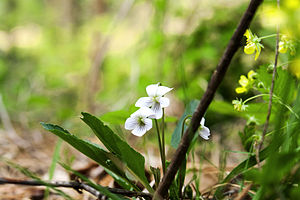Note: This is a project under development. The articles on this wiki are just being initiated and broadly incomplete. You can Help creating new pages.
Viola patrinii
Viola patrinii is a stemless, herbaceous perennial plant growing from a short, stout rhizome; it produces clusters of 3 - 5 or more basal leaves 7 - 20cm tall. The plant is harvested from the wild for local use as a food and a medicine. The dried herb is traded for medicinal purposes in local markets and exported from China to other Chinese communities around the world.
Contents
[hide]- 1 Uses
- 2 Parts Used
- 3 Chemical Composition
- 4 Common names
- 5 Properties
- 6 Habit
- 7 Identification
- 8 List of Ayurvedic medicine in which the herb is used
- 9 Where to get the saplings
- 10 Mode of Propagation
- 11 How to plant/cultivate
- 12 Commonly seen growing in areas
- 13 Photo Gallery
- 14 References
- 15 External Links
Uses
Cancer, Abscesses, Inflammations, Ulcers.[1]
Parts Used
Chemical Composition
It contains Two isoflavonoids, tectorigenin-7-O-β-D-glucoside and luteolin-7-O-β-D-glucurono pyranoside were isolated from ethyl acetate fraction of Viola patrinii fermentation extracts.[2]
Common names
| Language | Common name |
|---|---|
| Kannada | |
| Hindi | |
| Malayalam | |
| Tamil | |
| Telugu | |
| Marathi | |
| Gujarathi | |
| Punjabi | |
| Kashmiri | |
| Sanskrit | |
| English |
Properties
Reference: Dravya - Substance, Rasa - Taste, Guna - Qualities, Veerya - Potency, Vipaka - Post-digesion effect, Karma - Pharmacological activity, Prabhava - Therepeutics.
Dravya
Rasa
Guna
Veerya
Vipaka
Karma
Prabhava
Habit
Identification
Leaf
| Kind | Shape | Feature |
|---|---|---|
Flower
| Type | Size | Color and composition | Stamen | More information |
|---|---|---|---|---|
| {{{5}}} |
Fruit
| Type | Size | Mass | Appearance | Seeds | More information |
|---|---|---|---|---|---|
Other features
List of Ayurvedic medicine in which the herb is used
Where to get the saplings
Mode of Propagation
How to plant/cultivate
Prefers a cool moist well-drained humus-rich soil in partial or dappled shade and protection from scorching winds. Tolerates sandstone and limestone soils but becomes chlorotic if the pH is too high. Prefers a pH between 6 and 6.5.[4]
Commonly seen growing in areas
Marshy meadows, Moist places along riversides, Thickets, Shaded places at forest margins.
Photo Gallery
References
- Jump up ↑ Indian Medicinal Plants by C.P.Khare
- Jump up ↑ Chemical constituents
- Jump up ↑ [Morphology]
- Jump up ↑ Cultivation
External Links
- Ayurvedic Herbs known to be helpful to treat Cancer
- Ayurvedic Herbs known to be helpful to treat Abscesses
- Ayurvedic Herbs known to be helpful to treat Inflammations
- Ayurvedic Herbs known to be helpful to treat Ulcers
- Herbs with Young leaves used in medicine
- Herbs with Flower buds used in medicine
- Habit - Perennial
- Index of Plants which can be propagated by Seeds
- Herbs that are commonly seen in the region of Marshy meadows
- Herbs that are commonly seen in the region of Moist places along riversides
- Herbs that are commonly seen in the region of Thickets
- Herbs that are commonly seen in the region of Shaded places at forest margins
- Herbs



